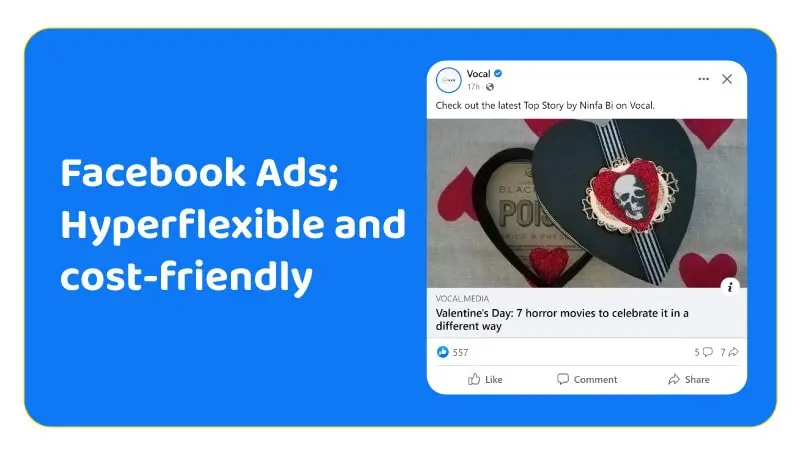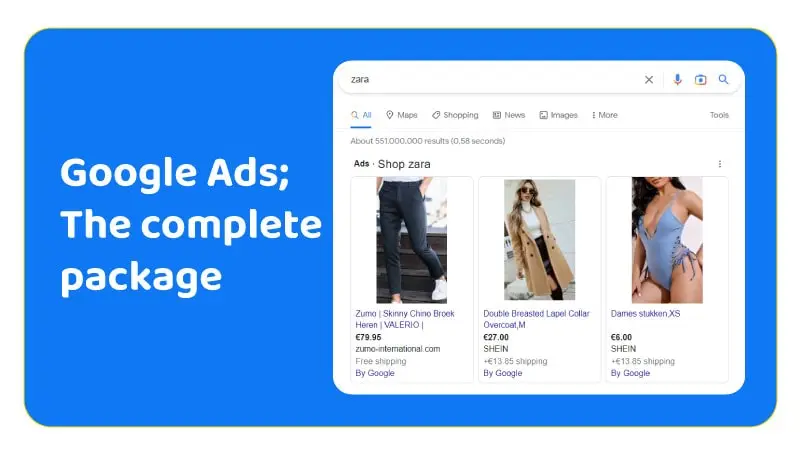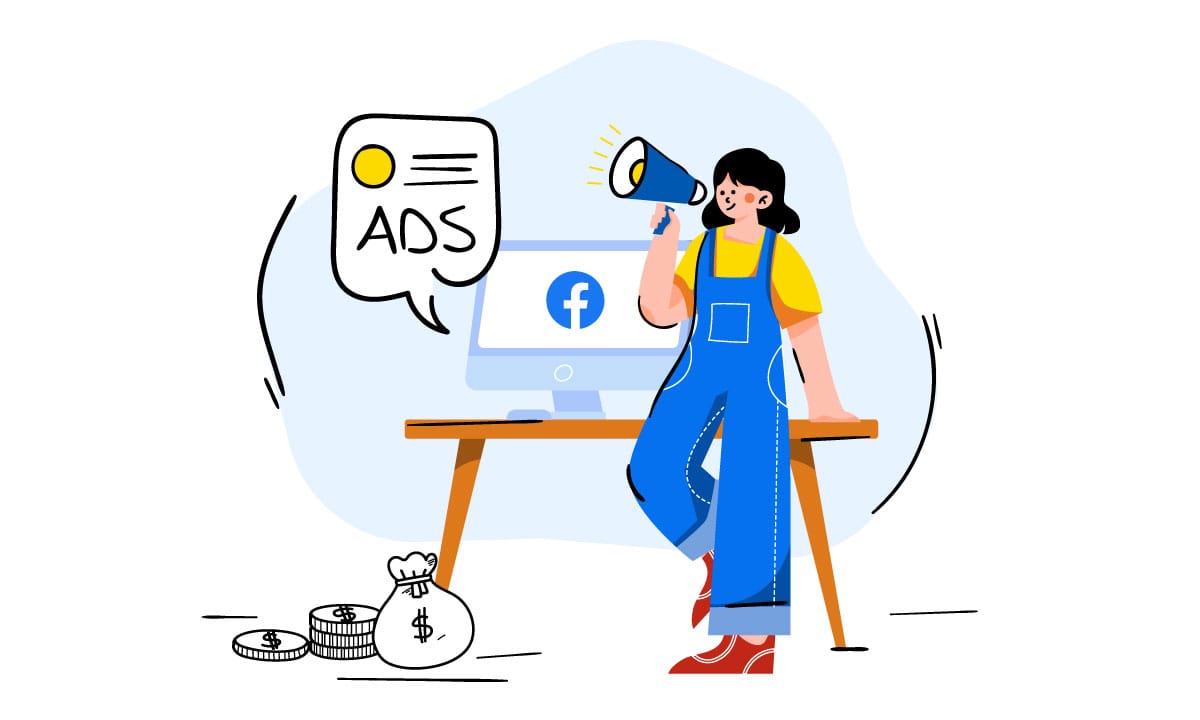Imagine this: you’ve just launched a new product or service and need to spread the word to potential customers. With a limited marketing budget, every dollar matters. So, where should you invest your advertising funds: Google Ads or Facebook Ads? Both platforms are widely used and offer distinct benefits. Google, the world’s largest search engine, handles over 3.5 billion searches daily.

The company’s advertising service, Google Ads (previously known as Adwords), provides a myriad of advertising opportunities across its vast network of websites, services, and apps. Facebook, on the other hand, has over 2.8 billion monthly active users and allows for hyper-targeted advertising to specific demographics and interests. Choosing between these two advertising giants can be a daunting task. That’s why in this article, we’ll explore the pros and cons of each platform to help you make an informed decision about which one is right for your business.
Facebook Ads; Hyperflexible and cost-friendly
Facebook Ads are a powerful tool for businesses of all sizes. With a gigantic user base of almost three billion people, Facebook provides an unparalleled opportunity to connect with a massive audience. But to make the most of this platform, you need to understand its targeting options, ad formats, and cost and bidding strategies.
Facebook’s audience targeting capabilities are mighty, giving advertisers the ability to narrow down their audience at a granular level. For example, if you’re selling pet food, you can target users who have shown an interest in pet care, pet adoption, or specific types of pets. There’s an impressive range of options to reach your ideal audience. You can target users based on demographics, interests, behaviors, and even custom audiences like people who have visited your website or engaged with your business on Facebook (carried out thanks to the amazing Facebook Pixel tracking tool). Facebook’s Lookalike Audiences feature also allows you to target people who are similar to your existing customers, expanding your reach to a new audience.

In addition to its powerful targeting options, Facebook also offers a variety of ad formats to choose from. Whether you want to create a photo ad, video ad, carousel ad, or collection ad, Facebook has you covered. Each format has its unique benefits and can be used to achieve different marketing objectives. For example, photo ads are great for showcasing your products or services, while video ads are excellent for telling a story and building brand awareness. One unique ad format that this platform offers is Meta Advantage ads (previously known as Dynamic Ads). These ads allow you to showcase specific products from your website to users who have already shown an interest in those products. For example, if a user visits your website and views a specific product, you can retarget them with a Facebook ad showcasing that same product, increasing the chances of conversion.
Facebook uses an auction-based system that lets you bid on ad placements based on your budget and goals. You can choose between two bidding strategies: cost per click (CPC) or cost per impression (CPM). CPC is ideal for driving traffic to your website, while CPM is better for building brand awareness. The average cost per click varies widely based on factors such as your target audience, ad placement, and bidding strategy. According to WordStream, the average CPC for Facebook Ads across all industries is around $1.72. However, this can vary depending on your niche and competition.
Google Ads; The complete package
Google Ads is currently the largest pay-per-click (PPC) advertising platform in the world. It enables allows businesses to connect with potential customers through a variety of ad formats. With over 246 million unique visitors in the US alone, Google Ads provides an unparalleled opportunity to reach a massive audience.
Google Ads also uses a CPC model, which means you only pay when someone clicks on your ad. The cost of a click depends on the competition for the ad’s targeted keywords and the bid you set. On average, businesses in the US spend $1 to $2 per click on Google Ads. However, the cost can vary widely depending on the industry, location, and other factors. Google provides businesses with a range of advertising formats that can help them reach their target audience. Each format has its own unique features and benefits.

- Paid search ads: These ads appear at the top of Google search results when users search for specific keywords. They are text-based and include a headline, description, and display URL. Advertisers bid on keywords that they want to target, and Google uses a real-time auction system to determine which ads will appear for a particular search query.
- Display ads: These ads appear on websites and apps that are part of the Google Display Network. They can be image, text, or video-based and are designed to capture a user’s attention while they browse the web. Advertisers can target specific audiences based on factors like interests, demographics, and behaviors.
- Shopping ads: These ads appear at the top of Google search results when users search for specific products. They include an image, price, and product name, and can be linked to a particular product page on a retailer’s website. Advertisers need to create a Google Merchant Center account and upload their product feed to run shopping ads.
- Video ads: These ads appear on YouTube and can be skippable or non-skippable. Advertisers can target specific audiences based on factors like interests, demographics, and behaviors. Video ads can be used to build brand awareness, drive website traffic, and promote products or services.
Each ad format has its own strengths and weaknesses, and businesses should choose the format that best suits their marketing goals and target audience. Paid search ads are effective for capturing users who are actively searching for a particular product or service. Display ads are useful for building brand awareness and reaching a broad audience. Shopping ads are ideal for e-commerce businesses looking to showcase their products. Finally, video ads can be a powerful tool for building brand awareness and driving engagement.
While Google Ads can be a powerful tool for businesses, it’s important to note that it can be complex and time-consuming to manage. To get the most out of your campaigns, you will need to spend time researching and selecting the right keywords, creating effective ad copy, and monitoring your campaigns for optimal performance. However, if executed properly, Google Ads can be a valuable tool for businesses of all sizes.
Comparing Google Ads and Facebook Ads
Now that we have an understanding of both Facebook Ads and Google Ads, let’s compare the two platforms. While both offer businesses a way to reach their target audience, they have different strengths and weaknesses that can affect a business’s advertising strategy. In this section, we’ll explore the key differences between Facebook Ads and Google Ads in terms of targeting options, ad format options, cost and bidding, and the advantages and disadvantages of each platform. By the end, you’ll have a better idea of which platform might be the best fit for your business.
- Targeting options comparison: Both Facebook Ads and Google Ads offer a variety of targeting options to help businesses reach the right audience. Facebook Ads allows advertisers to target based on interests, behaviors, demographics, and location. Google Ads allows advertisers to target based on keywords, location, and demographics. One key advantage of Facebook Ads is that it can target users based on their activity on the platform, such as pages they’ve liked or events they’ve attended, which can provide a more targeted approach than Google Ads.
- Ad format options comparison: Facebook Ads and Google Ads also have different ad format options. Facebook Ads offers image and video-based ads that can appear in the user’s newsfeed, stories, and other areas of the platform. Google Ads offers search, display, shopping, and video ads. Each platform has its own unique ad formats that businesses can use to reach their target audience. One advantage of Google Ads is the shopping ads, which can be particularly effective for e-commerce businesses.

- Cost and bidding comparison: The cost of advertising on Facebook Ads and Google Ads can vary depending on a number of factors. On Facebook Ads, businesses can set a daily or lifetime budget and bid for ad placement in an auction system. On Google Ads, businesses can set a daily budget and bid on keywords. The cost per click (CPC) can vary depending on the competition for that keyword. One advantage of Facebook Ads is that it can be more cost-effective for businesses with smaller budgets. At the same time, Google Ads can be more expensive due to the higher competition for certain keywords.
- Advantages and disadvantages of each platform: Both Facebook Ads and Google Ads have their own advantages and disadvantages. Facebook Ads can be more effective for targeting specific demographics and interests and can be more cost-effective for smaller budgets. However, it may not be as effective for businesses targeting users who are actively searching for a specific product or service. On the other hand, Google Ads can be more effective for businesses targeting users who are actively searching for a specific product or service but can be more expensive and complex to manage.
Which one works better for your business?
Choosing between Facebook Ads and Google Ads can be a tough decision for businesses. While both platforms offer ways to reach your target audience, they have different strengths and weaknesses that can affect your advertising strategy. Here are some factors to consider when deciding between the two:
- Marketing goals: The first thing to consider is your marketing goals. Are you looking to increase brand awareness, drive traffic to your website, or generate more sales? Depending on your goals, one platform might be more effective than the other. For example, if your goal is to generate sales, Google Ads might be a better choice since it allows you to target users who are actively searching for a specific product or service.
- Target audience: The next thing to consider is your target audience. Who are you trying to reach? Facebook Ads can be more effective for targeting specific demographics and interests, while Google Ads can be more effective for targeting users who are actively searching for a specific product or service.
- Budget: Your budget will also play a role in your decision. Facebook Ads can be more cost-effective for businesses with smaller budgets, while Google Ads can be more expensive due to the higher competition for certain keywords.
- Industry: The industry you’re in can also play a role in your decision. For example, e-commerce businesses might find that Google Ads’ shopping ads are more effective, while B2B businesses might find that Facebook Ads’ targeting options are more effective.
- Testing: Finally, it’s important to test both platforms and see which one works best for your business. You might find that one platform performs better than the other, or that a combination of the two works best.
While deciding between Google Ads and Facebook Ads can be difficult, the good news is that you don’t necessarily have to choose one over the other. In fact, using both platforms together can be a powerful way to maximize your exposure and reach your target audience from different angles.
You can take advantage of a combination of Google Ads and Facebook Ads campaigns for prospecting and generating brand awareness. The extensive targeting abilities of both platforms let you target specific demographics and interests, as well as retarget users who have interacted with your brand in the past. Google Ads also allows you to target users who are actively searching for a specific product or service, as well as reach users on other Google-owned properties like YouTube.
Using both platforms together can also help you reach users at different stages of the buying process. For example, a user might see your Facebook Ad and become aware of your brand, but then search for your product on Google and make a purchase. By using both platforms together, you can ensure that you’re reaching your target audience at every stage of their buying journey. This strategy works exceptionally well for drophippers who find themselves unable to decide between Facebook Ads vs Google Ads for drophipping.
Overall, using a combination of Google Ads and Facebook Ads in your marketing strategy can be a powerful way to maximize your exposure and reach your target audience more effectively. By understanding the strengths and weaknesses of each platform and getting the hang of their respective advertising suites, you can create a more effective advertising strategy for your business. The good news is, whether you pick Facebook Ads, Google Ads, or both, you could always take advantage of a powerful Google Ads spy and Facebook Ads spy tool to immediately jump ahead of the curve and create winning campaigns right off the bat. (AdFlex provides both in one package!)
Conclusion
When it comes to choosing between Google Ads and Facebook Ads, there is no one-size-fits-all answer. Both platforms offer unique advantages and disadvantages, and the choice ultimately depends on your specific business needs and marketing goals. By understanding the differences between the two platforms, and considering the factors we’ve discussed, you can make an informed decision and create a successful advertising strategy that reaches your target audience effectively. Additionally, by combining the strengths of both platforms, you can maximize your exposure and reach your audience in different ways, ultimately resulting in more success for your business.
FAQs
What is the main difference between Google Ads and Facebook Ads?
Google Ads primarily targets users who are actively searching for specific products or services, while Facebook Ads targets users based on their demographics, interests, and behaviors.
Which platform is more expensive, Google Ads or Facebook Ads?
The cost of advertising on either platform depends on a variety of factors, including your target audience, ad format, and bidding strategy. On average, however, Google Ads tends to be more expensive than Facebook Ads, particularly for competitive keywords and industries.
How do I decide which platform to use for my business?
The choice between Google Ads and Facebook Ads ultimately depends on your specific business needs and marketing goals. Consider factors such as your target audience, ad budget, and marketing objectives, and test out both platforms to see which works best for you.
Can I use Google Ads and Facebook Ads together in my marketing strategy?
Yes. In fact, using a combination of both platforms can be a powerful way to maximize your exposure and reach your target audience from different angles. By understanding the strengths and weaknesses of each platform and using them together strategically, you can create a more effective advertising strategy for your business.







 Facebook Ads Spy Tool
Facebook Ads Spy Tool TikTok Ads Spy Tool
TikTok Ads Spy Tool